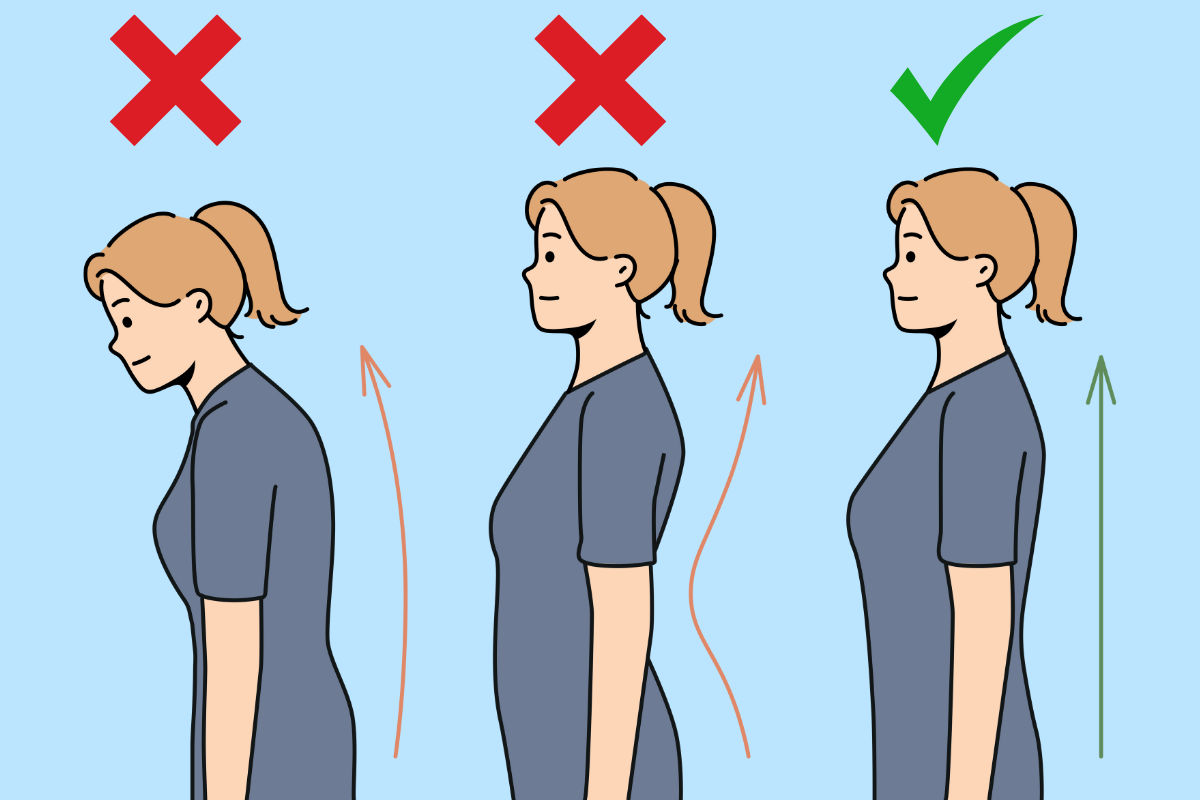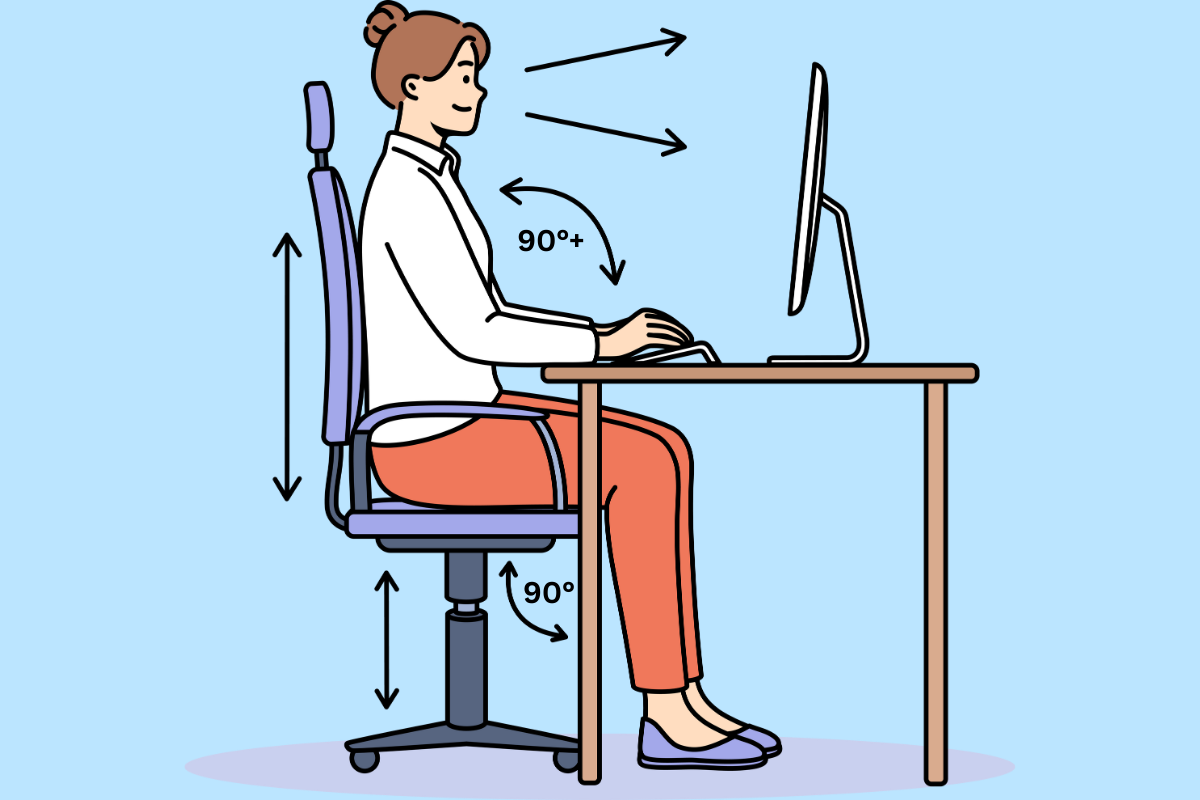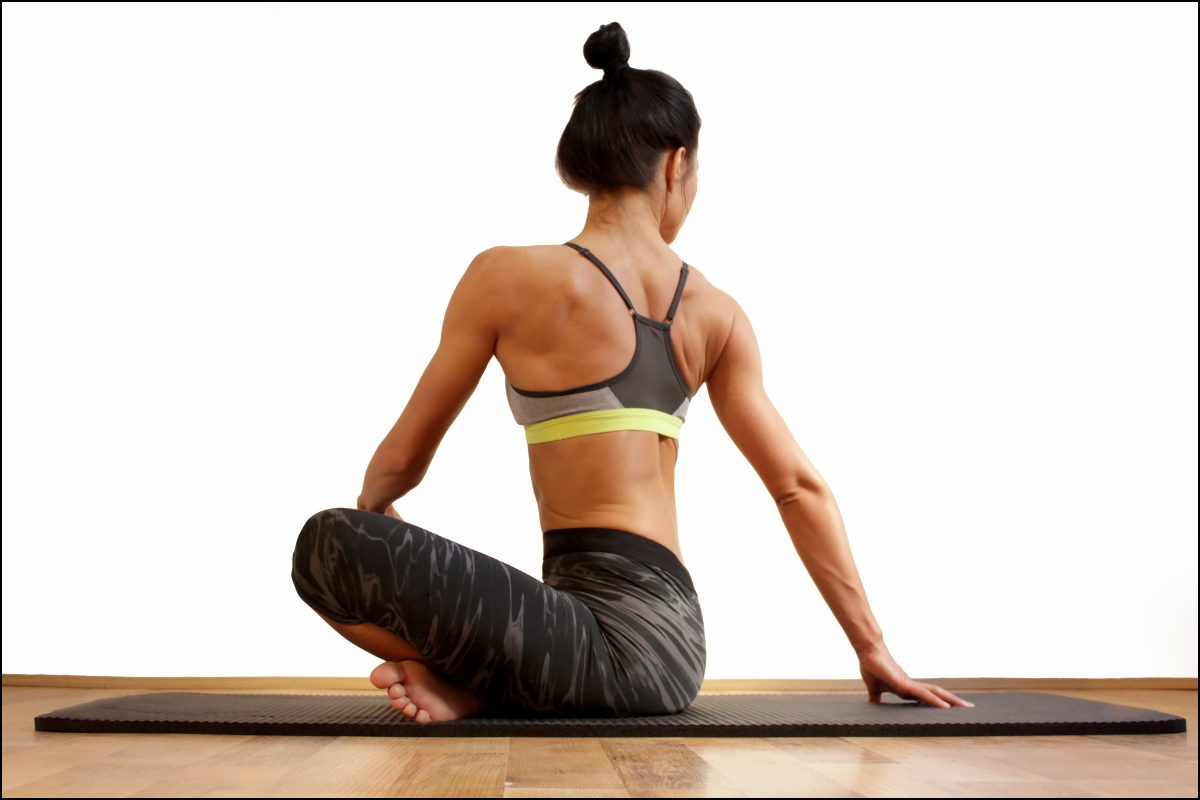Many of us don’t think about our posture throughout the day. That is, we don’t think about it until our neck starts to hurt or getting up is a struggle. Even if you do recognize it, you may not know how to fix bad posture or think it’s not worth the effort.
But it is! How we hold our bodies can significantly affect our overall health, physical abilities, and mental well-being.
Unfortunately, modern life has made bad posture all too common without us even realizing it. The way we look down at our phones, the hours spent hunched over a computer or curled up on the couch, the lack of exercise and strength training — we’re all guilty of it. But these things lead to poor posture and weak back and neck muscles.
Over time, it all wreaks havoc on our bodies.
Luckily, it is never too late to build back strength and learn how to fix bad posture.
The Impact of Bad Posture on Health
Bad posture isn’t just about aesthetics—it has real consequences for your health.
It’s probably obvious that it causes back and neck strain. But you might not know how serious that is. Bad posture and poor ergonomics can cause musculoskeletal problems that lead to:
- Loss of balance,
- Decreased range of motion,
- Chronic joint, neck, back, and shoulder pain,
- Frequent headaches
- Numbness and tingling in your extremities,
- Carpal tunnel and related conditions,
- An increased risk for injuries,
- And possibly even herniated discs and degenerative joint disease.
These problems only worsen as you age, especially if you do nothing to correct them. Chronic pain and lack of mobility negatively affect your ability to work, ease of doing daily activities and hobbies, and your mental health.
Even worse, those aren’t the only issues that can arise if you don’t know how to fix bad posture.

Other Problems Caused by Bad Posture
- Breathing Issues: Slouching or hunching over can compress your lungs, reducing their capacity to expand fully and weakening your chest and core muscles. This combination can lead to shallow breathing, which limits the amount of oxygen your body receives. Over time, you’ll experience reduced energy levels and possibly feelings of fatigue or anxiety.
- Digestive Problems: Poor posture, especially after meals, compresses your internal organs, including your stomach and intestines. This can slow down digestion and potentially lead to issues like acid reflux, indigestion, constipation, and even incontinence.
- Poor Circulation: When you compress internal organs, you also compress your veins and arteries, which impedes blood flow. Poor circulation can result in varicose veins, blood clots, and possibly severe cardiovascular problems.
- Mental Health: Interestingly, posture can also affect your mood and mental state. Research has shown that people who sit or stand upright tend to feel more confident and have higher self-esteem than those who slouch. Conversely, poor posture can be associated with feelings of depression or low energy.

How to Fix Bad Posture
Improving your posture does not happen overnight, but with consistent effort, you can see significant improvements.
The first step is to be mindful of how you sit and stand and assess if it’s a good posture. Some people overcompensate by pushing their chests out or squeezing their shoulder blades together. But good posture feels natural, especially once you’re used to it. There shouldn’t be any straining or pushing.
You know your standing position is correct if:
- Your head is directly above your shoulders, chin parallel to the floor
- Shoulders are above your hips
- The core is slightly engaged, with hips jutting forward, not pointing down
- Weight is distributed evenly between both feet
This position should allow your spine to maintain its natural, healthy curves without putting pressure on vertebrae.

Fixing Your Posture at Work
Once you know how to fix bad posture while standing, you’ll have an easier time doing it in a chair. Yes, your sitting position is just as important—even more so if you work at a desk or drive a lot.
First, your head and shoulders should be in the same position as when standing. Therefore, if your computer screen is too low or pushed back, causing neck strain, try repositioning it closer to you. You can also add a computer riser or books under the monitor so you don’t have to look down.
Your chair should always support your lower back, and your feet should be able to rest flat on the floor in front of you. Situate your legs from your body at a 90° to 110° angle. Ergonomic chair cushions can help achieve this position if your seat isn’t supportive enough.
Finally, ensure your chair is correctly situated with your keyboard and desk. This means that your elbows form a 90° angle while typing or writing.
Even if you have an active job and rarely sit, the ergonomics of how you move is still vital to your health and posture.
- Avoid positions where you are working above your head or lifting your hands above your shoulders for extended periods.
- Always follow proper lifting techniques, and wear a back support belt for heavy lifting and frequent bending.
- Be mindful of how much force you use in a task, and don’t push yourself beyond your abilities.
Lastly, take breaks.
Regardless of the type of work you do, and even while relaxing on the couch, frequently change your position and move. Both repetitive movements and long-held static positions cause strain on your muscles and joints. Take a break every 30-60 minutes to walk around, stretch, and move your body.

More Ways to Fix Bad Posture
Other than correct body positioning, there are more things you can do to ensure you have good posture.
- Strengthen Your Core — A strong core, which includes your stomach, hips, lower back, and pelvis, is essential for good posture and mobility. Practice engaging your core muscles to help support your spine and prevent poor posture. You can also incorporate core strengthening exercises into your daily routine.
- Support your feet—Feet are also important for posture as they are the source of your foundation. Wear quality shoes that support your specific foot shape and the activities you do. Avoid high heels and flat, unsupportive shoes as your main footwear, especially if you work on your feet. They are fine in moderation but can lead to many problems if you wear them frequently. If you consistently stand in one place, use a cushioning mat that helps support both your feet and back.
- Sleep Right — Your sleeping posture matters too. Try to sleep on your back or, even better, your side with a pillow that supports the natural curve of your neck. Avoid sleeping on your stomach, as this strains your neck and back. If you are a diehard stomach sleeper, make these modifications for a healthier spine.
- Use a flat pillow or none at all. This reduces the angle of your neck.
- Put a pillow under your pelvis to support a straighter spine.
- Buy a firm mattress or remove any mattress topper you might have.
- To reduce twisting your spine, keep your legs straight and level rather than raising one above the other.
- Stretch and Exercise — Maintaining strong, freely moving muscles and joints helps to support naturally good posture. It can also help you keep a consistent, healthy-for-you weight, which is vital because extra weight can cause or exacerbate poor posture.

Stretches and Exercises to Improve Posture
Once you know how to fix bad posture by making ergonomic adjustments, you can begin to strengthen the muscles that support good posture. Specific stretches and mobility exercises will help you further improve and maintain proper positioning and posture throughout your life.
Here are some to include in your daily routine:
- Chest Stretch — Counteracts the tightness in the chest muscles that often leads to rounded shoulders.
How to Do It: Stand in a doorway and place your forearms on either side of the doorframe at shoulder height. Gently lean forward until you feel a stretch across your chest. Hold for 20-30 seconds. - Cat-Cow Stretch — Improves spinal flexibility and relieves tension in the back.|
How to Do It: Begin on all fours with your hands under your shoulders and knees under your hips. Inhale as you arch your back, dropping your belly towards the floor (Cow Pose). Exhale as you round your back towards the ceiling (Cat Pose). Repeat 10-15 times. - Thread the Needle — Increases flexibility in your thoracic spine while stretching your shoulder muscles.
How to Do It: Still on all fours, inhale and gently twist your body to raise your right hand to the sky as you look up. Exhale, bring your arm down, and slide it across the floor under your left arm. Bend your left elbow as your right shoulder kisses the floor. Repeat 5 times and switch sides. - Spinal Twist — Improves mobility in the middle back, which is crucial for maintaining good posture.
How to Do It: Sit on the floor with your legs crossed. Inhale, place both hands behind your head, and exhale as you rotate your upper body to one side. Inhale, return to center and exhale while turning to the other side. Repeat 10 times. - Wall Angels — Strengthens the muscles between your shoulder blades and improves shoulder mobility.
How to Do It: Stand with your back against a wall, feet a few inches away. Press your lower back into the wall and bring your arms up to form a “W” shape. Slowly raise your arms overhead, keeping them in contact with the wall, then lower them back down. Repeat 10 times. - Plank — Strengthens the core muscles that support good posture.
How to Do It: Lie face down on the floor, then lift your body onto your hands and toes, keeping your body in a straight line. Hold for 20-60 seconds, ensuring your back doesn’t sag or arch. You can modify your plank by keeping your knees on the floor until you build more strength. Another modification is to lift your front body onto your forearms rather than hands. This is helpful for those with weaker wrists. - Downward Dog — Stretches the lower back and builds strength in the shoulders and core.
How to Do It: From a plank or modified plank position, lift your hips to the sky as you support yourself on your hands and feet, creating an upside-down V shape. Take three to four deep breaths as you hold. It is okay if your heels don’t touch the ground at first. Focus on the shape and breathing. To decrease tension in your wrists, be sure your fingers and knuckles are pushing into the floor. - Bridge Pose — Strengthens the glutes and lower back, which are crucial for maintaining a neutral spine.
How to Do It: Lie on your back with your knees bent and feet flat on the floor. Lift your hips towards the ceiling, squeezing your glutes at the top, hold for a full breath, then lower back down. Repeat 15-20 times.

Learn How to Fix Bad Posture for Your Health
Figuring out how to fix bad posture is not just about looking better—it’s about feeling better and living a healthier, more active life.
By understanding the impact of poor posture on your body and taking proactive steps to improve it, you can prevent many of the aches, pains, and health issues associated with it.
Incorporating simple stretches and exercises into your daily routine can make a world of difference in how you feel and move. So, stand tall, sit straight, and give your body the support it needs to function at its best.






